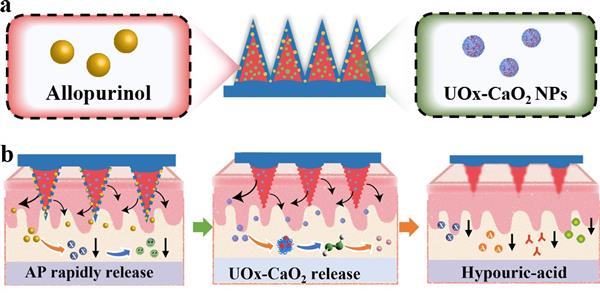由博士研究生王瑞等完成的研究论文“Core-shell structured microneedles with programmed drug release functions for prolonged hyperuricemia management”被《Journal of Materials Chemistry B》录用!
祝贺!!
Abstract: An appropriate non-oral platform via transdermal delivery of drugs is highly recommended for the treatment of hyperuricemia. Herein, a core-shell structured microneedle patch with programmed drug release functions was designed to regulate serum uric acid (SUA) levels for prolonged hyperuricemia management. The patch was fabricated using a three-step-casting method. Allopurinol (AP), an anti-hyperuricemic drug, was encapsulated within the carboxymethyl cellulose (CMC) layer, forming the "shell" of the MNs. The MNs inner core was composed of polyvinylpyrrolidon (PVP) loaded with urate oxidase-calcium peroxide nanoparticles (UOx-CaO2 NPs). When the as-fabricated core-shell structured microneedles were inserted into the skin, the loaded AP was first released immediately to effectively inhibit the production of SUA due to the water-solubility of CMC. Subsequently, the internal SUA was further metabolized by UOx, leading to exposure of CaO2 NPs. The sustained release of UOx accompanied by the decomposition of CaO2 NPs which was contributed to maintaining a state of normal uric acid levels over an extended period. More attractively, the uric acid could be oxidized due to the strong oxidant of CaO2, which was beneficial to the continuous consumption of uric acid. In vivo results showed that the as-fabricated MNs exhibited an excellent anti-hyperuricemia effect to reduce SUA level to normal state within 3 h and maintain normouricemia state for 12 h. In addition, the levels of creatinine (Cr), and blood urea nitrogen (BUN) in serum remained within normal range, and the activities of adenosine deaminase (ADA) and xanthine oxidase (XOD) in the liver were effectively inhabited, mitigating the risk of liver and kidney damages for clinical anti-hyperuricemia management.
